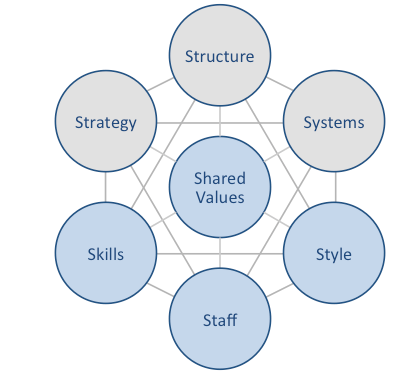Google McKinsey 7S Model
Google McKinsey 7S model illustrates how seven business elements can be aligned to increase effectiveness. Strategy, structure and systems are hard elements, whereas shared values, skills, style and staff represent soft elements. McKinsey 7S model attempts to illustrate that a change in one element causes changes in others. As it is illustrated in figure below, shared values are positioned at the core of Google McKinsey 7S model, since shared values guide employee behaviour with implications in their performance.
Google McKinsey 7S model
Hard Elements
Strategy. Google core business strategy is business diversification and introduction of new products and services in a regular manner. Google business strategy is also based on the development of a closed eco-system to motivate customers to use greater range of products and services. Customers usually enter this ecosystem through using Chrome browser, watching YouTube videos or using Gmail. In no time, they are prompted to use additional services such as Drive, Play, Calendar, Blogger and others. Alphabet Inc., Google’s parent company also uses acquisitions business strategy extensively and more than 200 companies and 30 acquisitions were made in 2015 and 2016 alone.
Structure. Google was restructured in 2015 to become a wholly owned subsidiary of a newly established parent company Alphabet Inc. Under the new structure, the company is divided into a number of divisions and each division is positioned as a separate brand such as Google, Calico, Nest, Access (Fiber) and others. The new structure helps the company to move beyond search engine business and to engage in diversification strategy to a greater extent.
Systems. Google operations rely on a wide range of systems such as employee recruitment and selection system, team development and orientation system, transaction processing systems, customer relationship management system, business intelligence system, knowledge management system and others. Additionally, ranking of web-pages according to search queries conducted by Google algorithm is a critically important system for the business.
Alphabet Inc. (Google) Report contains a full analysis of Google McKinsey 7S Model. The report illustrates the application of the major analytical strategic frameworks in business studies such as SWOT, PESTEL, Porter’s Five Forces and Value Chain analysis on Google. Moreover, the report contains analyses of Alphabet leadership, business strategy organizational structure and organizational culture. The report also comprises discussions of Alphabet marketing strategy and addresses issues of corporate social responsibility.


